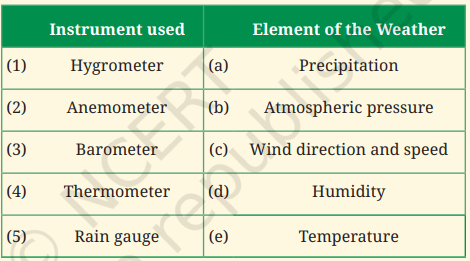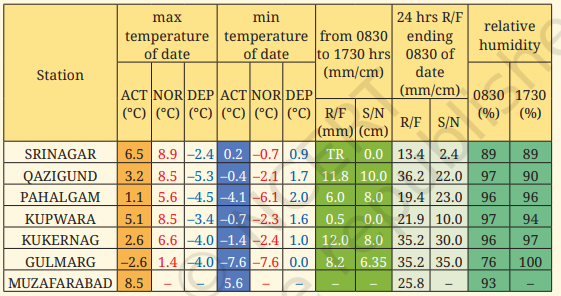Solutions For All Chapters – Social Science Class 7
Understanding the Weather
Questions and activities
1. Match the instrument with the weather element it measures.
Answer:
| Instrument Used | Element of the Weather |
|---|---|
| Hygrometer | Humidity |
| Anemometer | Wind direction and speed |
| Barometer | Atmospheric pressure |
| Thermometer | Temperature |
| Rain gauge | Precipitation |
Explanation: Each instrument measures a specific weather element:
- Hygrometer measures humidity (amount of water vapor in the air).
- Anemometer measures wind direction and speed.
- Barometer measures atmospheric pressure.
- Thermometer measures temperature.
- Rain gauge measures precipitation (rainfall or snowfall).
2. Jyotsna is deciding what clothes to pack for her school trip to Mumbai in June. She looks at the weather forecast, which predicts 29°C and 84% humidity. What would be your advice to her?
Answer:
I would advise Jyotsna to pack light and breathable clothes, such as cotton t-shirts, shorts, or loose dresses, because Mumbai in June will be warm at 29°C. Since the humidity is high at 84%, it will feel sticky and sweaty, so she should choose clothes that allow air to circulate and keep her cool. She should also pack an umbrella or raincoat, as June is the start of the monsoon season in Mumbai, and rain is likely. Additionally, comfortable footwear that can get wet, like sandals, would be a good choice.
3. Imagine that a small group of students is setting up a rain gauge. Here are some options for the site:
The school vegetable garden.
The terrace of the school building.
Open ground with elevated platform.
Compound wall of the school.
Verandah of the school laboratory.
Discuss in your group and finalize the site. Write down the reasons for your decision.
Answer: The best site for setting up the rain gauge is Option 3: Open ground with elevated platform.
Reasons for the decision:
- Open area: The open ground ensures that the rain gauge is not obstructed by trees, buildings, or walls, which could block or redirect rainfall, leading to inaccurate measurements.
- Elevated platform: The elevated platform keeps the rain gauge stable and prevents it from being tilted or toppled by wind. It also avoids water splashing from the ground into the gauge, which could affect the readings.
- No interference: Unlike the vegetable garden (where plants or soil might interfere), the terrace (where building edges might block rain), the compound wall (which is too narrow and exposed to wind), or the verandah (which is covered and would prevent rain from entering), the open ground with an elevated platform provides a clear and accurate collection of rainfall.
- Stability and safety: The elevated platform ensures the rain gauge is secure and can be placed on a flat surface, as recommended for accurate measurements.
4. Below is a chart taken from IMD, Jammu and Kashmir. Looking at the data available, write a short script to report the weather conditions in different parts of Jammu and Kashmir on the date shown. (Hint: Cover the temperature range, maximum and minimum temperatures, humidity, precipitation, etc.)
Daily Weather Parameters Jammu & Kashmir (EVENING) DATE: 01-02-2024
Answer:
Script for Weather Report:
“Good evening, everyone! This is your weather update for Jammu and Kashmir on February 1, 2024, brought to you by the India Meteorological Department.
Starting with Srinagar, it was a chilly day with a maximum temperature of 6.5°C, slightly below the normal 8.9°C, and a minimum of 0.2°C. The humidity was high at 89% throughout the day, and there was a trace amount of rainfall, indicating a damp and cold atmosphere.
In Qazigund, the weather was colder, with a maximum temperature of 3.2°C, much lower than the normal 8.5°C, and a minimum of -0.4°C. Precipitation was significant, with 11.8 mm of rainfall and 10 cm of snowfall recorded. Humidity was very high, ranging from 90% to 97%, making it feel quite wet and frosty.
Pahalgam saw even colder conditions, with a maximum temperature of just 1.1°C and a minimum of -4.1°C, both well below normal. The area received 6 mm of rainfall and 8 cm of snowfall, with humidity at 96%, indicating a snowy and freezing day.
Kupwara had a maximum temperature of 5.1°C and a minimum of -0.7°C, with a small amount of rainfall at 0.5 mm. Humidity ranged from 94% to 97%, suggesting a cold and moist environment.
In Kukernag, the maximum temperature was 2.6°C, and the minimum was -1.4°C. The area experienced 12 mm of rainfall and 8 cm of snowfall, with humidity between 96% and 97%, making it another snowy and cold spot.
Gulmarg was the coldest station, with a maximum temperature of -2.6°C and a minimum of -7.6°C, perfect for snow lovers! It recorded 8.2 mm of rainfall and 6.35 cm of snowfall, with humidity ranging from 76% to 100%, indicating a very wet and icy day.
Finally, Muzafarabad had a milder day with a maximum temperature of 8.5°C and a minimum of 5.6°C. Rainfall was significant at 25.8 mm, and humidity was high at 93%.
Overall, Jammu and Kashmir experienced cold, wet, and snowy conditions today, with high humidity across most areas. Stay warm and safe, and keep your umbrellas and snow gear ready! That’s all for today’s weather update!”
The Big Questions (Page 27)
1. How can we measure and monitor the weather around us?
Answer: We can measure and monitor the weather using special instruments that track different elements of the weather, such as temperature, precipitation, atmospheric pressure, wind, and humidity. These instruments include:
- Thermometer: Measures temperature (how hot or cold it is) in degrees Celsius or Fahrenheit.
- Rain Gauge: Measures precipitation, like rainfall or melted snow, in millimeters.
- Barometer: Measures atmospheric pressure, which is the weight of the air, in millibars.
- Anemometer and Wind Vane: Measure wind speed (in kilometers per hour) and direction.
- Hygrometer: Measures humidity, which is the amount of water vapor in the air, as a percentage.
These instruments are often combined in weather stations, like Automated Weather Stations (AWS), which use sensors to collect data on all these elements at regular intervals. Meteorologists study this data to monitor weather changes and understand patterns in a particular place over time. For example, recording maximum and minimum temperatures or rainfall helps track how the weather behaves.
2. How do weather predictions help us prepare for events like heavy rain, storms, drought, and heat waves?
Answer: Weather predictions help us prepare for extreme weather events like heavy rain, storms, drought, and heat waves by giving us advance warnings and information to plan and stay safe. Here’s how:
- Heavy Rain: Predictions alert people about possible flooding, so they can move to safer areas, protect their homes, or avoid traveling. For example, farmers can protect crops, and cities can clear drainage systems to prevent waterlogging.
- Storms: Forecasts warn fishermen not to go out to sea and help coastal areas prepare for strong winds or evacuate if a cyclone is coming. This saves lives and reduces damage.
- Drought: Predictions of low rainfall help farmers plan irrigation and choose drought-resistant crops. Governments can arrange water supply and food reserves for affected areas.
- Heat Waves: Forecasts warn people to stay hydrated, avoid outdoor activities during the hottest times, and use cooling measures. Schools or workplaces may adjust schedules to keep people safe.
Meteorologists use data from weather instruments and study patterns to make these predictions. Accurate forecasts allow governments, communities, and individuals to mobilize resources, like emergency supplies or evacuation plans, and take action to reduce the impact of these events.



Leave a Reply